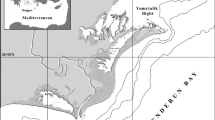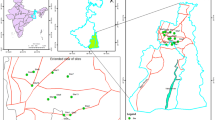Abstract
Copper (Cu) contamination is serious in China, with ≤2.76 mg/L in some waters. Exposure to Cu causes a high toxicity to the aquatic organisms and subsequent ecological risk. To understand fish responses to Cu exposure, we analyzed the metabonomic changes in multiple tissues (gill, liver, and muscle) of Cyprinus flammans using an nuclear magnetic resonance-based metabonomic technique. Our results showed that metabolic alterations are dose-dependent. No significant metabolic alterations in three tissues of fish are caused by 0.25 mg/L Cu. However, 1.53 mg/L Cu caused changes of energy-related metabolites and amino acids, which we suggest are due to enhanced metabolic acidosis in gill and muscle, decreased tricarboxylic acid cycle activity in muscle, increased gluconeogenesis from amino acids in liver, and improved glycogenesis in liver and muscle. The Cori cycle between liver and muscle is concurrently triggered. Furthermore, high concentration of Cu resulted in the alteration of choline metabolism such that we hypothesize that Cu induces membrane damage and detoxification of CuSO4 in gill as well as altered osmoregulation in all three tissues. Choline-O-sulfate in gill may be used as a biomarker to provide an early warning of Cu exposure in C. flammans. Moreover, Cu exposure caused alterations of nucleoside and nucleotide metabolism in both gill and muscle. These findings provide a new insight into the metabolic effects of Cu exposure on C. flammans and highlight the value of metabonomics in the study of metabolic metal disturbance in fish.




Similar content being viewed by others
References
Alcock NW (1987) Copper. In: Pesce AJ, Kaplan LA (eds) Methods in clinical chemistry. Mosby, Missouri, pp 527–538
Boitel F, Truchot JP (1989) Effects of sublethal and lethal copper levels on hemolymph acid-base balance and ion concentrations in the shore crab Carcinus maenas kept in undiluted sea water. Mar Biol 103(4):495–501
Brosnan JT (2003) Interorgan amino acid transport and its regulation. J Nutr 133(6):2068S–2072S
Carr WES, Netherton JC, Gleeson RA, Derby CD (1996) Stimulants of feeding behavior in fish: analyses of tissues of diverse marine organisms. Biol Bull 190(2):149–160
Coen M, Lenz EM, Nicholson JK, Wilson ID, Pognan F, Lindon JC (2003) An integrated metabonomic investigation of acetaminophen toxicity in the mouse using NMR spectroscopy. Chem Res Toxicol 16(3):295–303
Couture P, Kumar PR (2003) Impairment of metabolic capacities in copper and cadmium contaminated wild yellow perch (Perca flavescens). Aquat Toxicol 64(1):107–120
Dai H, Xiao CN, Liu HB, Tang HR (2010) Combined NMR and LC-MS analysis reveals the metabonomic changes in Salvia miltiorrhiza Bunge induced by water depletion. J Proteome Res 9(3):1460–1475
De Boeck G, Borger R, van der Linden A, Blust R (1997) Effects of sublethal copper exposure on muscle energy metabolism of common carp, measured by 31P-nuclear magnetic resonance spectroscopy. Environ Toxicol Chem 16(4):676–684
De Boeck G, Vlaeminck A, Balm PHM, Lock RAC, De Wachter B, Blust R (2001) Morphological and metabolic changes in common carp, Cyprinus carpio, during short-term copper exposure: interactions between Cu2+ and plasma cortisol increase. Environ Toxicol Chem 20(2):374–381
De Boeck G, Meeus W, De Coen W, Blust R (2004) Tissue-specific Cu bioaccumulation patterns and differences in sensitivity to waterborne Cu in three freshwater fish: rainbow trout (Oncorhynchus mykiss), common carp (Cyprinus carpio), and gibel carp (Carassius auratus gibelio). Aquat Toxicol 70(3):179–188
De Boeck G, van der Ven K, Hattink J, Blust R (2006) Swimming performance and energy metabolism of rainbow trout, common carp and gibel carp respond differently to sublethal copper exposure. Aquat Toxicol 80(1):92–100
De Boeck G, van der Ven K, Meeus W, Blust R (2007) Sublethal copper exposure induces respiratory stress in common and gibel carp but not in rainbow trout. Comp Biochem Physiol C 144(4):380–390
De Boeck G, Smolders R, Blust R (2010) Copper toxicity in gibel carp Carassius auratus gibelio: importance of sodium and glycogen. Comp Biochem Physiol C 152(3):332–337
Effler SW, Litten S, Field SD, Tong-Ngork T, Hale F (1980) Whole lake responses to low level copper sulfate treatment. Water Res 14(10):1489–1499
Eriksson L, Trygg J, Wold S (2008) CV-ANOVA for significance testing of PLS and OPLS (R) models. J Chemom 22(11–12):594–600
Eyckmans M, Benoot D, Van Raemdonck GAA, Zegels G, Van Ostade XWM, Witters E et al (2012) Comparative proteomics of copper exposure and toxicity in rainbow trout, common carp and gibel carp. Comp Biochem Physiol Part D 7(2):220–232
Fan TWM (1996) Metabolite profiling by one- and two-dimensional NMR analysis of complex mixtures. Prog Nucl Magn Reson Spectrosc 28:161–219
Fan TWM, Lane AN (2008) Structure-based profiling of metabolites and iotopomers by NMR. Prog Nucl Magn Reson Spectrosc 52:69–117
Fiess JC, Kunkel-Patterson A, Mathias L, Riley LG, Yancey PH, Hirano T et al (2007) Effects of environmental salinity and temperature on osmoregulatory ability, organic osmolytes, and plasma hormone profiles in the Mozambique tilapia (Oreochromis mossambicus). Comp Biochem Physiol A 146(2):252–264
Graham JE, Wilkinson BJ (1992) Staphylococcus aureus osmoregulation: roles for choline, glycine betaine, proline, and taurine. J Bacteriol 174(8):2711–2716
Hanson AD, Rathinasabapathi B, Chamberlin B, Gage DA (1991) Comparative physiological evidence that β-alanine betaine and choline-O-sulfate act as compatible osmolytes in halophytic Limonium species. Plant Physiol 97(3):1199–1205
Hanson AD, Rathinasabapathi B, Rivoal J, Burnet M, Dillon MO, Gage DA (1994) Osmoprotective compounds in the Plumbaginaceae: a natural experiment in metabolic engineering of stress tolerance. Proc Natl Acad Sci USA 91(1):306–310
Harris ED (2000) Cellular copper transport and metabolism. Annu Rev Nutr 20:291–310
Hashemi SM, Ghods S, Kolodgie FD (2008) A placebo controlled, dose-ranging, safety study of allogenic mesenchymal stem cells injected by endomyocardial delivery after an acute myocardial infarction. Eur Soc Cardiol 29(2):251–259
Heath AG (1991) Effect of water-borne copper on physiological responses of bluegill (Lepomis macrochirus) to acute hypoxic stress and subsequent recovery. Comp Biochem Physiol Part C 100(3):559–564
Holmes E, Tang H, Wang Y, Seger C (2006) The assessment of plant metabolite profiles by NMR-based methodologies. Planta Med 72(9):771–785
Jobling M (ed) (1994) Environmental tolerances and preferences. In: Fish bioenergetics. Chapman and Hall, London, UK, pp 207–294
Karan V, Vitorović S, Tutundzić V, Poleksić V (1998) Functional enzymes activity and gill histology of carp after copper sulfate exposure and recovery. Ecotoxicol Environ Saf 40(1–2):49–55
Klein J (2000) Membrane breakdown in acute and chronic neurodegeneration: focus on choline-containing phospholipids. J Neural Transmit 107(8–9):1027–1063
Kluytmans JHFM, Veenhof PR, De Zwaan A (1975) Anaerobic production of volatile fatty acids in the sea mussel Mytilus edulis (L.). J Comp Physiol 104(1):71–78
Kunwar PS, Tudorache C, Eyckmans M, Blust R, De Boeck G (2009) Influence of food ration, copper exposure and exercise on the energy metabolism of common carp (Cyprinus carpio). Comp Biochem Physiol C 149(1):113–119
Lardon I, Nilsson GE, Stecyk JAW, Vu TN, Laukens K, Dommisse R et al (2012) 1H-NMR study of the metabolome of an exceptionally anoxia tolerant vertebrate, the crucian carp (Carassius carassius). Metabolomics 9(2):311–323
Laurén DJ, McDonald DG (1985) Effects of copper on branchial ionoregulation in the rainbow trout, Salmo gairdneri Richardson. J Comp Physiol B 155(5):635–644
Lindon JC, Nicholson JK, Holmes E, Everett JR (2000) Metabonomics: metabolic processes studied by NMR spectroscopy of biofluids. Concepts Magn Reson 12(5):289–320
Litchfield JT, Wilcoxon F (1949) A simplified method of evaluating dose-effect experiments. J Pharmacol 96(2):99–113
Mallat J (1985) Fish gill structural changes induced by toxicants and other irritants: a statistical review. Can J Fish Aquat Sci 42(4):630–648
Martello LB, Tjeerdema RS, Smith WS, Kauten RJ, Crosby DG (1998) Influence of salinity on the actions of pentachlorophenol in Haliotis as measured by in vivo 31P NMR spectroscopy. Aquat Toxicol 41(3):229–250
Nawaz M, Manzl C, Krumschnabel G (2005) In vitro toxicity of copper, cadmium, and chromium to isolated hepatocytes from carp, Cyprinus carpio L. Bull Environ Contam Toxicol 75(4):652–661
Park YI, Gander JE (1998) Choline derivatives involved in osmotolerance of Penicillium fellutanum. Appl Environ Microbiol 64(1):273–278
Rhodes D, Hanson AD (1993) Quaternary ammonium and tertiary sulfonium compounds in greater plants. Ann Rev Plant Physiol Plant Mol Biol 44:357–384
Rivoal J, Hanson AD (1994) Choline-O-sulfate biosynthesis in plants (identification and partial characterization of a salinity-inducible choline sulfotransferase from species of Limonium (Plumbaginaceae). Plant Physiol 106(3):1187–1193
Samuelsson LM, Förlin L, Karlsson G, Adolfsson-Erici M, Larsson DG (2006) Using NMR metabolomics to identify responses of an environmental estrogen in blood plasma of fish. Aquat Toxicol 78(4):341–349
Seiichi U, Emiko K, Jiro K (2008) Super(1)H-NMR metabolomic evaluation on pollutants using fish plasma. Jpn J Environ Toxicol 11(2):63–67
Shofer SL, Willis JA, Tjeerdema RS (1997) Effects of hypoxia and toxicant exposure on arginine kinase function as measured by 31P NMR magnetization transfer in living abalone. Comp Biochem Physiol C 117(3):283–289
Tracey BS, David AS, Lindy T, Karen GB, Louis EB, Arezue FBB et al (2010) Metabolomic analysis of Atlantic blue crab, Callinectes sapidus, hemolymph following oxidative stress. Metabolomics 6(2):250–262
Van Scoy AR, Yu Lin C, Anderson BS, Philips BM, Martin MJ, McCall J et al (2010) Metabolic responses produced by crude versus dispersed oil in Chinook salmon pre-smolts via NMR-based metabolomics. Ecotoxicol Environ Saf 73(5):710–717
Wu H, Wang W (2010) NMR-based metabolomic studies on the toxicological effects of cadmium and copper on green mussels Perna viridis. Aquat Toxicol 100(4):339–345
Wu H, Wang W (2011) Tissue-specific toxicological effects of cadmium in green mussels (Perna viridis): nuclear magnetic resonance-based metabolomics study. Environ Toxicol Chem 30(4):806–818
Xiao CN, Hao FH, Qin XR, Wang YL, Tang HR (2009) An optimized buffer system for NMR-based urinary metabonomics with effective pH control, chemical shift consistency and dilution minimization. Analyst 134(5):916–925
Zhang LB, Liu XL, You LP, Zhou D, Wang Q, Li F, Cong M et al (2011) Benzo(a)pyrene-induced metabolic responses in Manila clam Ruditapes philippinarum by proton nuclear magnetic resonance (1H NMR) based metabolomics. Environ Toxicol Pharmacol 32(2):218–225
Acknowledgments
This study was supported by Ningbo Agricultural Technologies R&D Project (Grant No. 2012C10027), Scientific Research Foundation of Ningbo University for Excellent Graduates (Grant No. PY20110018), and K. C. Wong Magna Fund in Ningbo.
Author information
Authors and Affiliations
Corresponding authors
Electronic supplementary material
Below is the link to the electronic supplementary material.
Rights and permissions
About this article
Cite this article
Hu, MY., Ye, YF., Xue, LY. et al. Tissue-Specific Metabolic Responses of Cyprinus flammans to Copper. Arch Environ Contam Toxicol 69, 112–122 (2015). https://doi.org/10.1007/s00244-015-0149-4
Received:
Accepted:
Published:
Issue Date:
DOI: https://doi.org/10.1007/s00244-015-0149-4




